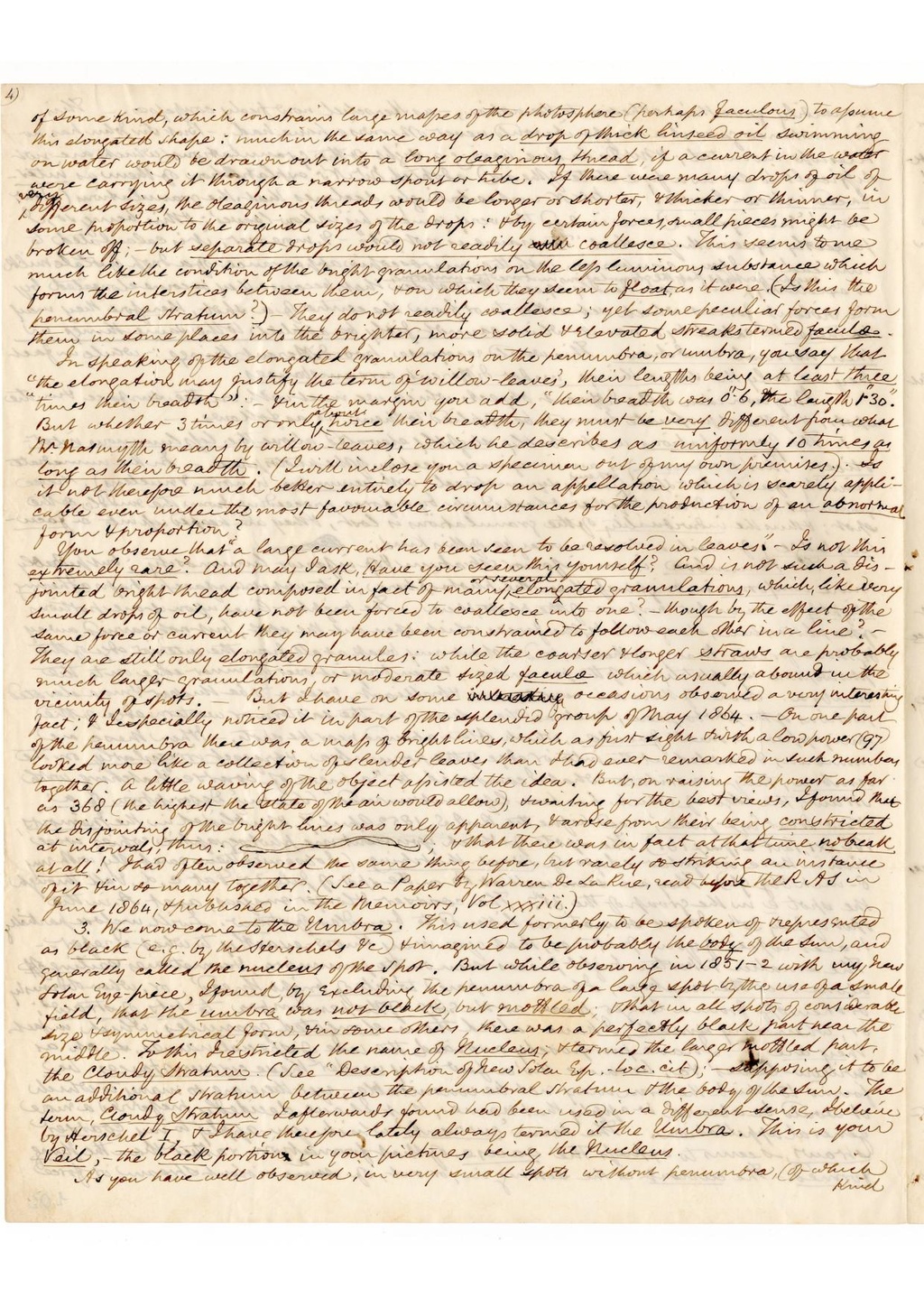of some kind, which constrains large masses of the photosphere (perhaps faculous) to assume this elongated shape: much in the same way as a drop of thick linseed oil swimming on water would be drawn out into a long oleaginous thread, if a current in the water were carrying it through a narrow spout or tube. If there were many drops of oil of very different sizes, the oleaginous threads would be longer or shorter, and thicker or thinner, in some proportion to the original sizes of the drops: and by certain forces, small pieces might be broken off; - but separate drops would not readily coallesce. This seems to me much like the condition of the bright granulations on the less luminous substance which forms the interstices between them, and on which they seem to float, as it were. (Is this the penumbral stratum?) - They do not readily coallesce; yet some peculiar forces form them in some places into the brighter, more solid and elevated streaks termed faculae.
In speaking of the elongated granulations on the penumbra, or umbra, you say that "the elongation may justify the term of 'willow-leaves', their lengths being at least three times their breadth": - and in the margin you add, "their breadth was 0"·6, the length 1"·30". But whether 3 times or only about twice their breadth, they must be very different from what Mr. Nasmyth means by willow-leaves, which he describes as uniformly 10 times as long as their breadth. (I will inclose you a specimen out of my own premises.). Is it not therefore much better entirely to drop an appellation which is scarely applicable even under the most favourable circumstances for the production of an abnormal form and proportion?
You observe that "a large current has been seen to be resolved in leaves." - Is not this extremely rare? And may I ask, Have you seen this yourself? And is not such a disjointed bright thread composed in fact of many or several elongated granulations, which, like very small drops of oil, have not been forced to coallesce into one? - though by the effect of the same force or current they may have been constrained to follow each other in a line? - They are still only elongated granules: while the coarser and longer straws are probably much larger granulations, or moderate sized faculae which usually abound in the vicinity of spots. - But I have on some occasions observed a very interesting fact; and I especially noticed it in part of the splendid group of May 1864. - On one part of the penumbra there was a mass of bright lines, which at first sight and with a low power (97) looked more like a collection of slender leaves than I had ever remarked in such numbers together. A little waving of the object assisted the idea. But, on raising the power as far as 368 (the highest the state of mean would allow), and waiting for the best views, I found that the disjointing of the bright lines was only apparent, and arose from their being constricted at intervals, thus: ; and that there was in fact at that time no break at all! I had often observed the same thing before, but rarely so striking an instance of it and in so many together. (See a Paper by Warren De La Rue, read before the RAS in June 1864, and published in the Memoirs, Vol xxxiii.)
3. We now come to the Umbra. This used formerly to be spoken of and represented as black (e.g. by the Mr Herschels/the Sterschels etc) and imagined to be probably the body of the Sun, and generally called the nucleus of the spot. But while observing in 1851—2 with my new Solar Eye-piece, I found, by excluding the penumbra of a large spot by the use of a small field, that the umbra was not black, but mottled; and that in all spots of considerable size and symmetrical form, and in some others, there was a perfectly black part near the middle. To this I restricted the name of Nucleus; and termed the larger mottled part, the Cloudy Stratum. (See "Description of New Solar Ep.-loc. cit); - supposing it to be an additional stratum between the penumbral stratum and the body of the Sun. The term, Cloudy Stratum I afterwards found had been used in a different sense, I believe by Herschel I, and I have therefore lately always termed it the Umbra. This is your Veil, - the black portion in your pictures being the Nucleus.
As you have well observed, in very small spots without penumbra, (of which kind
